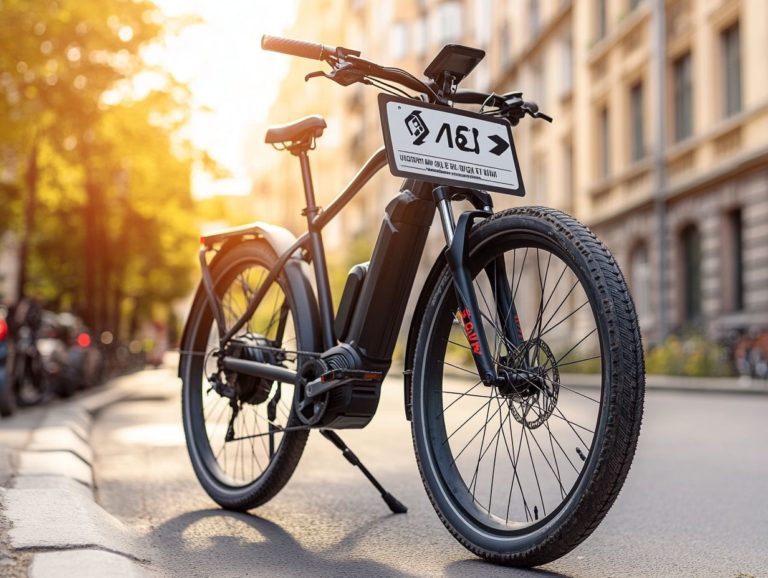Electric Bicycle Buying Guide for Beginners
Electric bicycles are transforming your perspective on commuting and leisure cycling.
This guide explores the many benefits of electric bicycles. We’ll highlight how they compare to traditional bikes and the environmental and health perks they provide.
Discover essential factors to consider when buying your e-bike! You’ll find tips to help you discover the perfect fit and maintenance advice to ensure your e-bike operates seamlessly.
Whether you re just starting out or contemplating an upgrade, this guide provides everything you need to make a well-informed decision.
Contents
- Key Takeaways:
- Benefits of Electric Bicycles
- Factors to Consider When Buying an Electric Bicycle
- Tips for Choosing the Right Electric Bicycle
- Maintenance and Care for Electric Bicycles
- Safety Gear for Electric Bicycles
- Frequently Asked Questions
- What is an electric bicycle?
- What are the advantages of buying an electric bicycle?
- What should I consider when buying an electric bicycle?
- Do I need a license to ride an electric bicycle?
- Can I ride an electric bicycle in all weather conditions?
- Do I need to wear a helmet when riding an electric bicycle?
Key Takeaways:
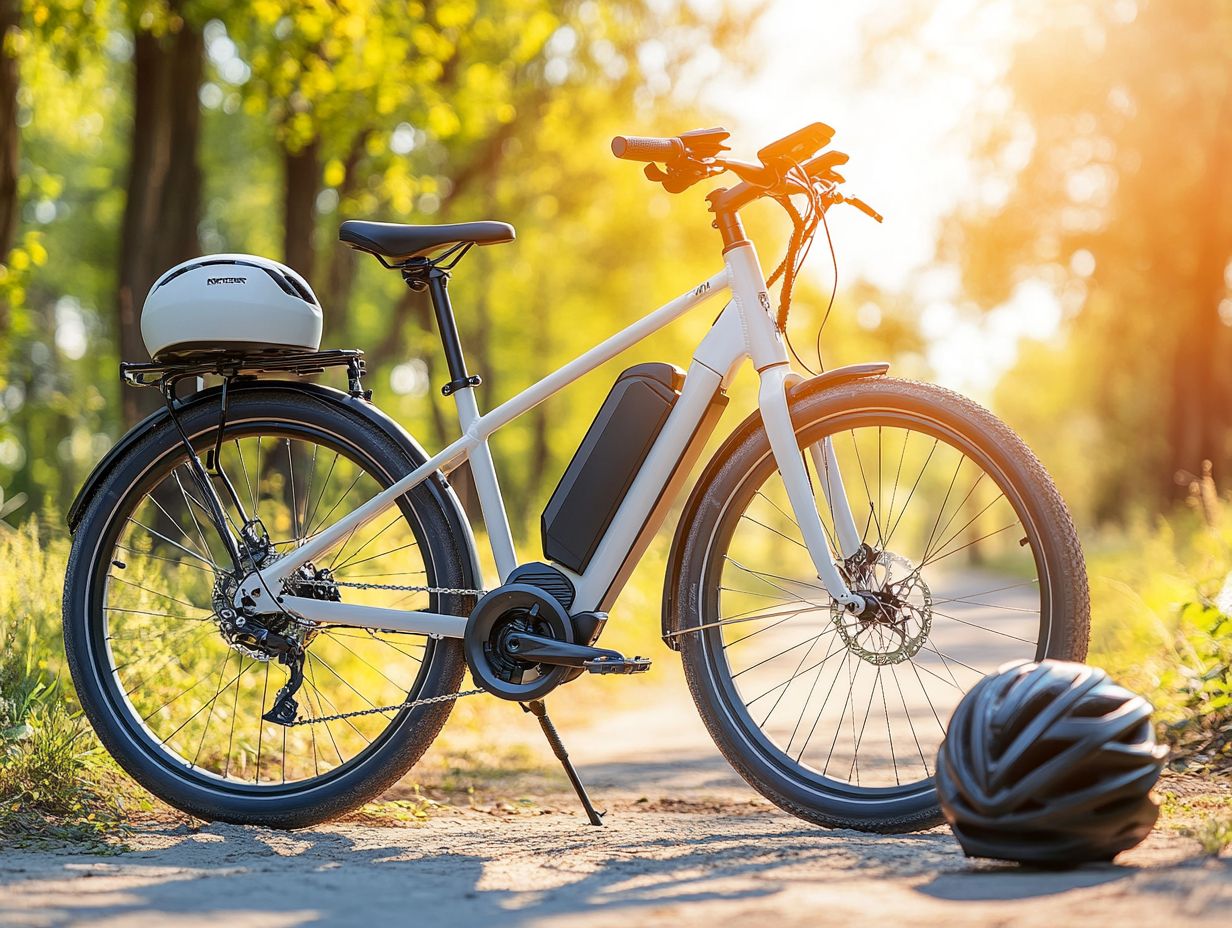
- Enjoy convenience, save money, and improve your health with electric bicycles.
- When buying an electric bicycle, consider factors such as price, motor and battery type, range, speed, design, and comfort including how hard you are pedaling and battery capacity.
- To choose the right electric bicycle, test ride different models and research reputable brands. Proper maintenance, including correct charging and storage, can prolong the lifespan of your e-bike.
What is an Electric Bicycle?
An electric bicycle, or e-bike, is a bicycle enhanced with an electric motor to assist your pedaling, making it an exceptional choice for sustainable transportation and urban commuting.
E-bikes come in various styles, including mountain bikes, hybrid bikes, and cargo bikes. If you’re unsure which option is best for you, check out our guide on how to choose an electric bicycle type for you. They offer different levels of motor assistance to suit your unique needs and preferences.
At the heart of an e-bike are key components that enhance their performance. They include a powerful electric motor, usually rated between 250 to 750 watts, and a dependable battery with a capacity ranging from 300 to 1000 watt-hours. To choose the best option for your needs, consider these 5 tips for selecting the right electric bike type. These elements work seamlessly together, ensuring smooth acceleration and effortless riding.
With advanced features like regenerative braking and smart displays, your riding experience is further enhanced. These features provide you with performance metrics and battery status at a glance.
As e-bikes gain recognition for their ability to reduce carbon footprints and offer an efficient alternative to traditional vehicles, it’s no surprise they are becoming increasingly popular in urban areas grappling with traffic congestion.
Benefits of Electric Bicycles
Electric bicycles present a wealth of advantages that position them as an attractive option for urban commuting. They excel in energy efficiency and boast a significantly lower environmental impact compared to traditional vehicles.
Electric bikes also offer a fun riding experience while alleviating the battery anxiety often linked with electric vehicles, thanks to advancements in electric bike components. This makes them a compelling choice for promoting sustainable transportation in today’s bustling cities.
Advantages over Traditional Bicycles
Electric bikes open up a world of advantages! They excel in ease of use and accessibility.
With features like adjustable pedal-assist levels and sensors that measure the force you apply while pedaling, e-bikes become an appealing choice for riders of all skill levels. For those new to e-bikes, exploring the electric bicycle types can enhance your riding experience, whether you’re commuting through busy streets or enjoying a leisurely ride.
Not only do electric bikes make uphill climbs a breeze, but they also enable you to cover longer distances without the fatigue often associated with standard cycling. This capability unlocks new adventures for both casual riders and long-distance enthusiasts, giving you the freedom to explore routes that may have once felt intimidating. To learn more about different options, check out electric bike types: understanding the basics, thus promoting energy efficiency.
The versatility of e-bikes is remarkable; they accommodate a range of riding styles, from easygoing cruising to more vigorous workouts. If you’re new to cycling, exploring the best budget electric bicycle types for beginners can help you customize your experience based on your mood or needs, enhancing the joy of cycling while fostering a more inclusive atmosphere for everyone.
Environmental and Health Benefits
The environmental and health benefits of electric bikes are truly impressive. They help lower carbon emissions and promote sustainable transportation options, which are essential considerations for modern urban living.
By choosing e-bikes, you not only embrace a fun and active lifestyle but also play a vital role in reducing your carbon footprint the total amount of greenhouse gases you are responsible for and improving air quality in urban environments.
Electric bikes help reduce reliance on fossil fuels and provide an eco-friendly alternative to traditional vehicles. This helps you become more aware of sustainable practices on the road!
Beyond their positive impact on the planet, e-bikes bring significant health advantages. Regular use enhances your cardiovascular fitness, elevates your mood through the release of endorphins, and integrates more physical activity into your daily routine.
The combination of exercise and fresh air also helps to lower stress levels, making electric bikes a holistic choice for enhancing both your personal well-being and environmental sustainability.
Factors to Consider When Buying an Electric Bicycle
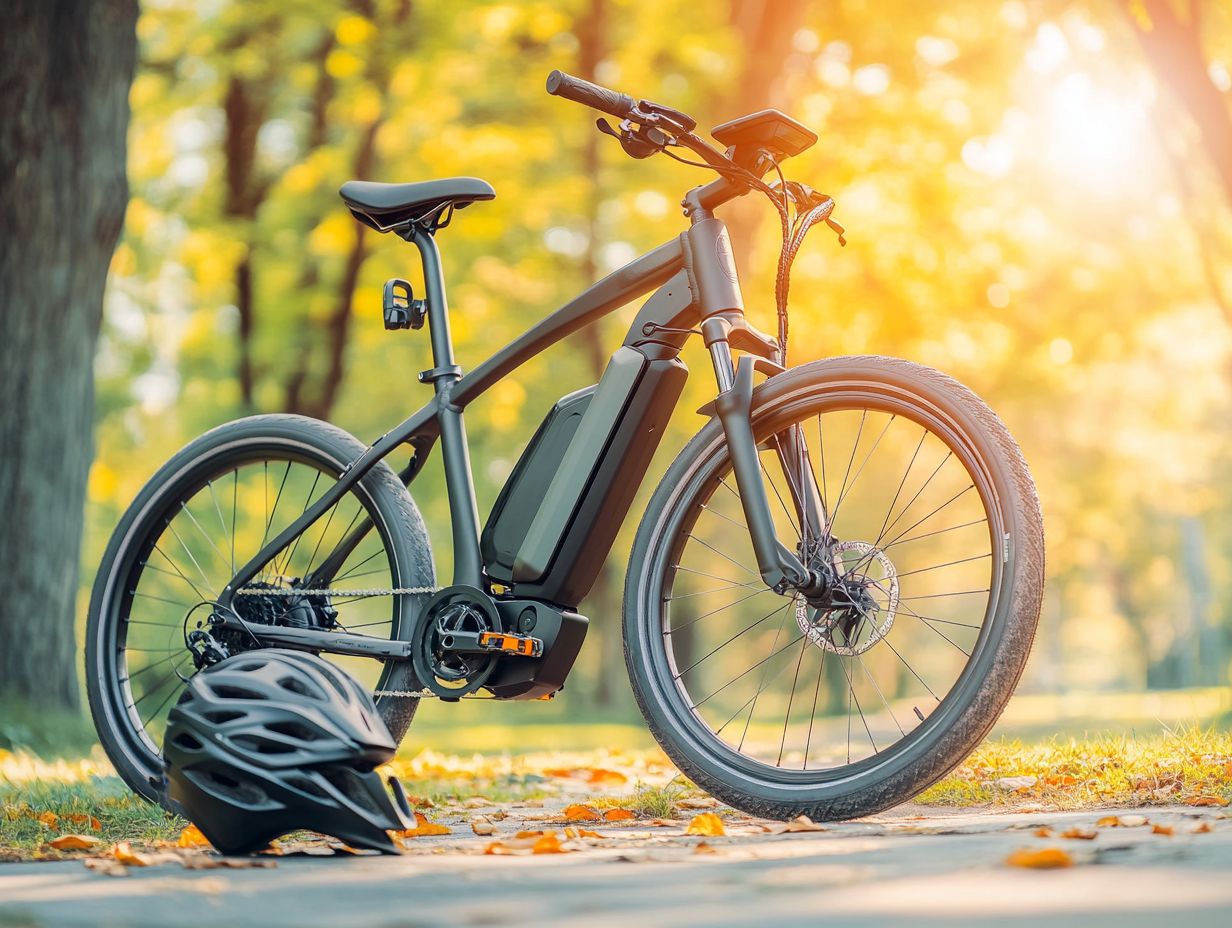
Looking for an electric bicycle? Keep several important factors in mind, such as the parts and features of the e-bike.
Think about your budget and the overall price, as well as the battery capacity, motor power, range, and speed.
Don’t overlook the design and comfort! By understanding these key elements, you can choose an e-bike that seamlessly aligns with your commuting needs and riding preferences.
Price and Budget
Determining the price and budget for an electric bike is crucial. E-bikes can vary significantly in cost based on features, brand, and quality, including renowned brands like Bosch, Yamaha, and Shimano.
Establishing a budget allows you to narrow down your options and choose an e-bike that meets your needs without overspending.
Price can vary based on several factors. Brand reputation often indicates reliability and performance.
A well-known manufacturer might offer cutting-edge technology features like enhanced battery life or smart connectivity options, which can elevate the overall cost.
Warranty options are also key longer warranties may suggest greater confidence in the product’s durability but can affect the price. To get the best value, research multiple brands and distinguish between essential and optional features.
Motor and Battery Type
Understanding the motor and battery type is crucial when selecting an electric bike. These components significantly influence your performance and riding experience. Different motors and batteries affect your range and speed. Therefore, it’s essential to choose wisely based on your riding style and route preferences.
You’ll commonly encounter two main types of motors in electric bikes: hub motors and mid-drive motors. Hub motors are located in the wheel hub and offer simplicity and ease of maintenance. This makes them an excellent choice for casual riders and urban commuting. In contrast, mid-drive motors are positioned near the pedals, providing better weight distribution and increased torque. These are ideal for climbing steep hills and tackling rough terrain, and you can learn more about these categories in our quick guide to electric bicycle classification.
The battery type you select lithium-ion being the most popular also affects the bike’s overall weight, range, and charging times, which are vital for effective urban commuting. Understanding these factors helps you optimize your riding experience, ensuring you select a bike that aligns with your lifestyle and adventurous aspirations.
Range and Speed
The range and speed of electric bikes are crucial elements that significantly affect your commuting and recreational experiences. These metrics can vary widely depending on the battery capacity and motor power. Knowing the expected range on a single charge enables you to plan your trips effectively, helping you avoid that pesky battery anxiety many new riders experience.
For example, some models can dazzle with impressive specifications, boasting ranges that exceed 60 miles on a full charge perfect for long-distance commutes. However, if you’re on the heavier side, you might see your range drop, especially on steep hills so keep this in mind! This underscores the importance of factoring in rider weight when evaluating performance.
E-bikes like the Trek Verve+ come equipped with various modes of assistance. This gives you the flexibility to choose settings that either focus on speed or prioritize battery conservation. Selecting an e-bike by choosing the right electric bicycle type for you ensures optimal performance, making it easier for beginners to adapt to different environments. This way, you meet the demands of daily travel while enjoying a smooth and delightful ride.
Design and Comfort
The design and comfort of electric bikes are crucial in shaping your riding experience. A well-crafted e-bike elevates your enjoyment and minimizes fatigue, especially during those longer commutes. When considering your options, pay attention to key features such as ergonomic designs, adjustable seating, and integrated safety gear.
The choice of frame materials is another factor that heavily influences the weight, durability, and shock absorption of the bike. You’ll want something that can handle uneven terrain with ease. Don’t underestimate aesthetic appeal; visual elements can inspire you to engage more deeply with your e-bike. For more guidance, consider choosing the right electric bicycle for your needs to make every ride a pleasure.
Handlebar configurations, including rise and sweep, significantly impact your posture, which in turn affects your overall comfort and handling. By concentrating on these design elements, e-bikes can cater to a diverse range of preferences and riding environments, ultimately enhancing your experience and encouraging you to ride more often.
Tips for Choosing the Right Electric Bicycle
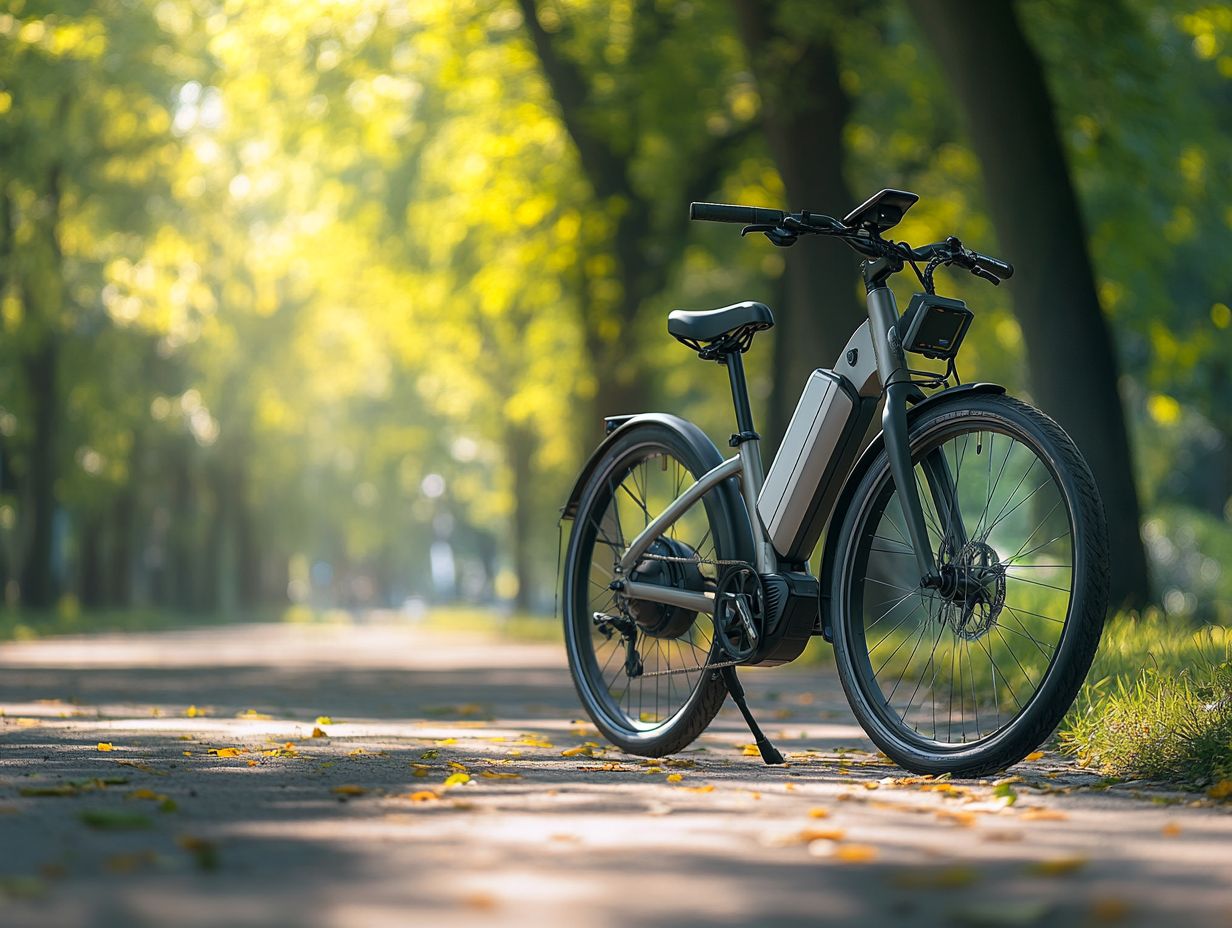
Finding your perfect electric bike is an exciting journey! Start by test riding various models and conducting thorough research on reputable brands. This process will enable you to find the perfect fit for your commuting needs.
By experiencing different e-bikes firsthand, you’ll gain invaluable insights into comfort, performance, and features. For a deeper dive into the various models available, consider understanding different types of electric bicycles. This ensures you make an informed decision that enhances your riding experience.
Maintenance and Care for Electric Bicycles
Maintaining your electric bicycle is essential for achieving optimal performance and extending its lifespan. This involves adhering to regular maintenance practices, such as following proper charging procedures and employing effective storage methods.
By taking meticulous care of your e-bike, you can prevent common issues and significantly enhance your overall riding experience.
Proper Charging and Storage
Proper charging and storage of your electric bike are crucial for prolonging battery life and ensuring reliable performance throughout its lifespan. Understanding the best practices for charging and the ideal storage conditions can help you avoid issues like worry about battery life and degradation over time.
For optimal charging, aim to follow a regular cycle that focuses on partial discharges instead of letting the battery fully deplete. Keeping the battery charged between 20-80% is a highly effective strategy for maintaining its longevity.
Avoid overcharging. It can lead to heat buildup and potential damage to the cells.
Regarding storage, make sure to keep your e-bike in a cool, dry place, away from direct sunlight. This helps protect it from environmental factors like humidity and extreme temperatures.
By adopting these practices, you can ensure that your electric bike remains in peak condition for years to come.
Troubleshooting Common Issues
Troubleshooting common issues with electric bikes is an essential skill for you as a rider. It enables you to diagnose problems quickly and effectively, ensuring a smoother riding experience. By familiarizing yourself with frequent challenges, you can maintain your e-bike and take preventive measures.
This includes being aware of potential battery issues, such as reduced range or charging difficulties, which may arise from poor connections or age-related wear. You might also encounter motor malfunctions, often signaled by unusual noises or performance lags, necessitating a closer inspection of connections and components.
Sensor issues can lead to erratic behavior, affecting your bike’s responsiveness. To tackle these concerns, it’s wise to regularly check and maintain connections, store the battery under optimal conditions, and conduct regular checks. By staying proactive, you can elevate your riding experience and extend the lifespan of your electric bicycle.
Safety Gear for Electric Bicycles
Wearing the right safety gear while riding electric bikes is essential for your safety and well-being. Key items like helmets, reflective clothing, and lights not only boost your visibility but also ensure you comply with local traffic regulations, making your urban commuting experience much safer and helping you navigate as a responsible rider.
Investing in gloves and padded shorts can greatly enhance your comfort and control, especially on those longer rides. Don t take chances wear your gear every time you ride!
Don’t overlook knee and elbow pads; they offer added protection in the event of falls or collisions, giving you peace of mind while you re out on the road.
Following traffic rules keeps you safe and shows you’re a responsible rider. Keeping an eye on speed limits, signaling your turns, and staying aware of your surroundings are vital practices that help minimize accidents, creating a safer environment for everyone sharing the road.
Frequently Asked Questions
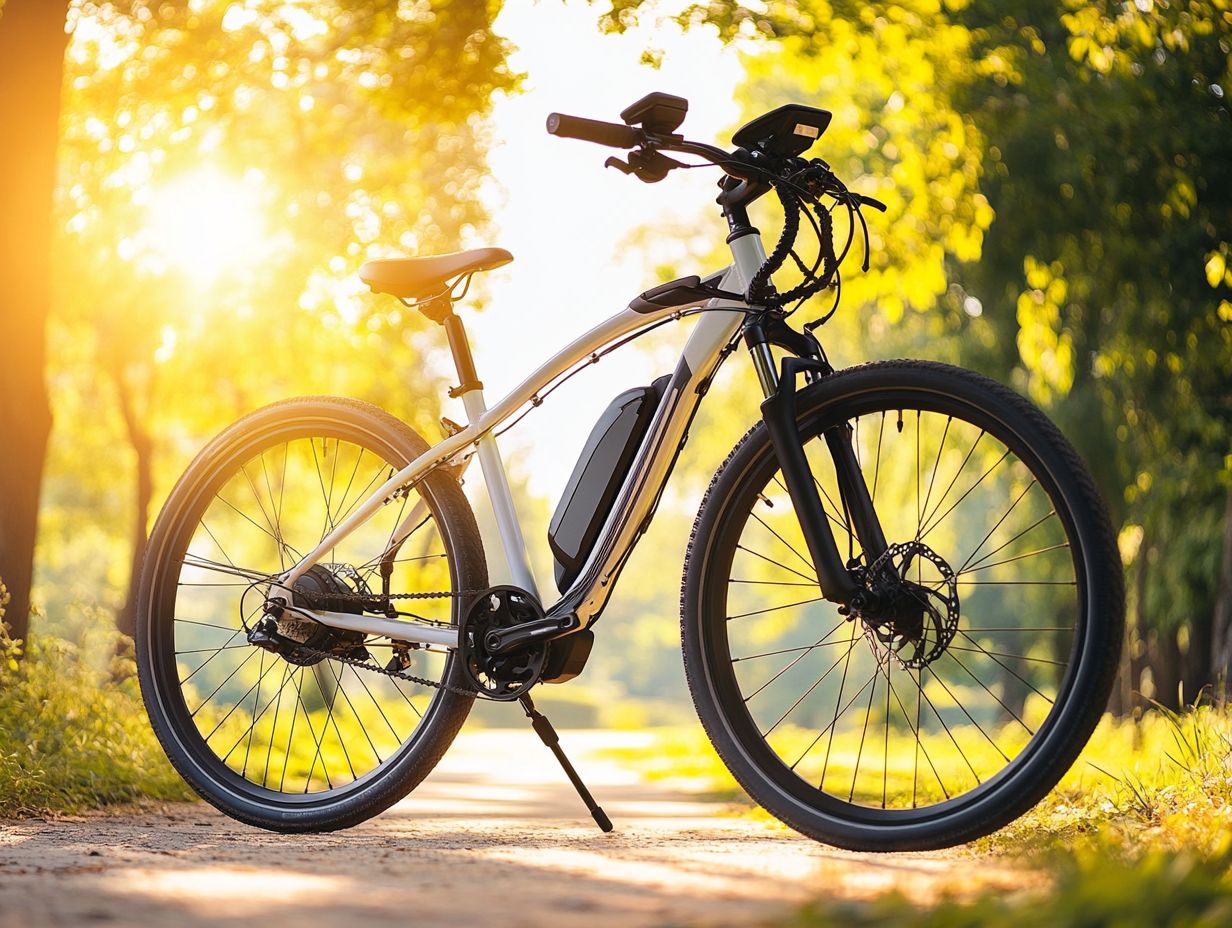
What is an electric bicycle?
An electric bicycle, also known as an e-bike, is a bicycle that is equipped with an electric motor to assist with propulsion. It allows for easier and faster cycling, making it a popular choice among commuters and recreational riders.
What are the advantages of buying an electric bicycle?
Electric bicycles have many advantages:
- Assisted pedaling: The electric motor helps with pedaling, making it easier to ride up hills and longer distances.
- Environmental friendliness: E-bikes produce zero emissions, making them a more sustainable mode of transportation.
- Cost savings: E-bikes can save money on transportation costs, as they do not require gas or parking fees.
- Health benefits: Even though the electric motor helps with pedaling, riding an e-bike still requires physical activity, providing health benefits.
If you have more questions, feel free to reach out for further assistance!
What should I consider when buying an electric bicycle?
- Motor power: A higher power rating means more strength for your e-bike.
- Battery life: Choose a battery that meets your travel needs, and check how long it takes to recharge.
- Frame and design: Your e-bike should be comfortable and fit your riding style.
- Cost: E-bikes range from a few hundred to a few thousand dollars. Set a budget before shopping.
- Warranty and maintenance: Choose a trustworthy brand with a solid warranty. Factor in maintenance costs too.
Do I need a license to ride an electric bicycle?
In most locations, you don t need a license to ride an electric bicycle. However, check local regulations as rules can vary.
Can I ride an electric bicycle in all weather conditions?
You can ride an electric bicycle in most weather. Heavy rain or snow might affect the motor’s performance, so always ride with caution.
Do I need to wear a helmet when riding an electric bicycle?
While helmet laws differ by location, wearing one is a smart choice for safety. Be sure to check local laws to see if it s required.





